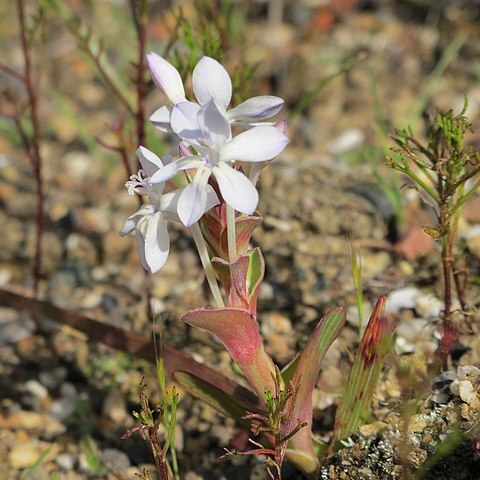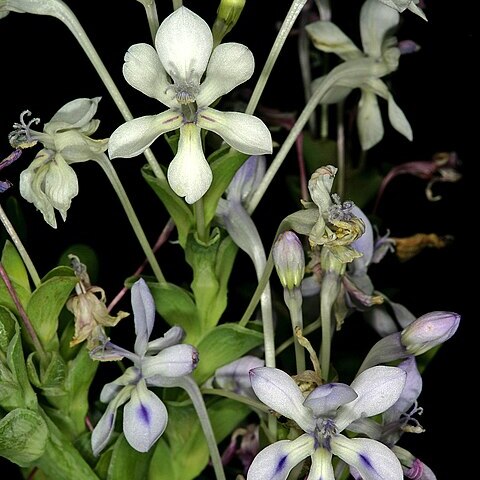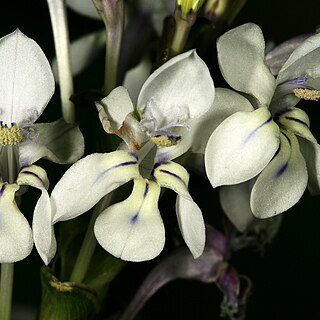Plants (50-)80-140 mm high. Corm bell-shaped, ± 10 mm diam.; tunics light red-brown, lightly ridged, basal margin entire or bluntly lobed. Stem simple or 1-to few-branched from near base, slightly compressed. Leaves 4 or 5, lowermost longest, up to 160 mm long, linear to lanceolate, 2-6 mm wide, strongly ribbed, upper leaves shorter and broader, becoming progressively bract-like above. Inflorescences 6-to 20-flowered spikes, initially 2-ranked, later becoming spiral; outer bracts green, firm, ± succulent, 10-20 mm long, channelled, ovate when flattened, obtuse in side view (deltoid and retuse when unfolded), apex deflexed in profile, margins hyaline; inner bracts 1/3-1/2 as long, transparent with 2 green keels. Flowers zygomorphic, either white to pale mauve, pale blue or pale pink, lower tepals each with a small triangular to diamond-shaped median mark in lower half (subsp. pyramidalis) or violet, purple or dark carmine, lower tepals each with white or cream-coloured markings near base and a central zone of darker pigment (subsp. regalis), either intensely sweet-scented day and night (subsp. pyramidalis) or evidently scentless (subsp. regalis); perianth tube 25-55 mm long, slender, straight or widening slightly in upper 5 mm; tepals subequal, narrowly to broadly ovate, narrowed into claw-like base ± 1.5 mm long, lower tepals each occasionally with a small claw-like cusp near base, dorsal tepal 9-15 x 6-7 mm, erect, held apart from others, upper lateral tepals slightly reflexed, lower 3 tepals usually held closely together and at right angles to tube, 8 x 5 mm. Stamens unilateral, ± erect to ascending; filaments 5-6 mm long, exserted ± 3.5 mm; anthers ± 3 mm long, usually pale yellow to white; pollen ± white. Style dividing between base and apex of anthers or slightly beyond; branches ± 2.5 mm long, forked for 1/2 their length, often becoming tangled in anthers. Capsules obovoid, 8-10 mm long, with wing-like locular ridges in distal half. Seeds ± globose to ovoid, usually somewhat flattened at chalazal end, 1.3-1.5 x 1.4-1.9 mm, epidermal cells tuberculate.
More
Cormous geophyte, 50-100 mm tall, branching at base, corm tunics brown, margins scalloped. Leaves linear, ribbed. Flowers several in short, often dense spikes, perianth tube cylindrical, cream to bluish, sweetly scented (or dark purplish to magenta and scentless in Olifants River Valley), bracts spreading, broad and retuse above.
Cormous geophyte, 5-10 cm. Leaf blades ribbed. Flowers long-tubed, cream-coloured to bluish and fragrant, or dark purplish to magenta and scentless, bracts spreading, broad and retuse above.



